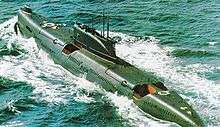Cruise missile submarine
A cruise missile submarine is a submarine that carries and launches cruise missiles (SLCMs and anti-ship missiles) as its primary armament. Missiles greatly enhance a vessel's ability to attack surface combatants and strike land targets, and although torpedoes are a more stealthy option, missiles give a much longer stand-off range, as well as the ability to engage multiple targets on different headings at the same time. Many cruise missile submarines retain the capability to deploy nuclear warheads on their missiles, but they are considered distinct from ballistic missile submarines due to the substantial differences between the two weapons systems' characteristics.
_Boat_Enh.jpg)
Originally early designs of cruise missile submarines had to surface to launch their missiles, while later designs could do so underwater via dedicated vertical launching system (VLS) tubes. Many modern attack submarines can launch cruise missiles (and dedicated anti-ship missiles) from their torpedo tubes while some designs also incorporate a small number of VLS canisters, giving some significant overlap between cruise missile submarines and traditional attack submarines. Nonetheless, vessels classified as attack submarines still use torpedoes as their main armament and have a more multi-role mission profile due to their greater speed and maneuverability, in contrast to cruise missile submarines which are typically larger slower boats focused on the long distance surface strike role.
The United States Navy's hull classification symbols for cruise missile submarines are SSG and SSGN – the SS denotes submarine, the G denotes guided missile, and the N denotes that the submarine is nuclear-powered.
U.S. Navy
The U.S. Navy's first cruise missile submarines were developed in the early 1950s to carry the SSM-N-8 Regulus missile. The first of these was a converted World War II era Gato-class submarine, USS Tunny, which was fitted with a hangar capable of carrying a pair of Regulus missiles. Tunny was used as a test-bed for developing techniques of use for the missile system, before a second boat, USS Barbero was subsequently converted. From 1957, these two boats undertook the first nuclear deterrent patrols.[1] Subsequently, two larger diesel submarines of the Grayback-class were purpose built for the carriage of the Regulus missile, with each capable of accommodating up to four missiles, while a further boat, the nuclear-powered USS Halibut, could carry up to five missiles. Between September 1959 and July 1964, the five Regulus missile boats undertook deterrent patrols in the Pacific Ocean,[2] in concert with the newly commissioned George Washington-class ballistic missile submarines (SSBN) in the Atlantic, until sufficient SSBNs were in service to replace them.
From 2002 to 2008, the U.S. Navy modified the four oldest Ohio-class submarines: Ohio, Michigan, Florida, and Georgia into SSGNs. The conversion was achieved by installing vertical launching systems (VLS) in a multiple all-up-round canister (MAC) configuration in 22 of the 24 missile tubes, replacing one Trident missile with 7 smaller Tomahawk cruise missiles. The 2 remaining tubes were converted to lockout chambers for use by special forces personnel. This gave each converted submarine the capability to carry up to 154 Tomahawks. The large diameter tubes can also be modified to carry and launch other payloads, such as UAVs or UUVs although these capabilities have not yet been fully implemented. In addition to generating a significant increase in stand-off strike capabilities, this conversion also counts as an arms reduction towards the START II treaty,[3][4] because it reduces the number of nuclear weapons that are forward-deployed. USS Florida (SSGN-728) launched cruise missiles against Libyan targets as part of Operation Odyssey Dawn in March 2011.
_firing_a_Regulus_missile_next_to_USS_Lexington_(CV-16)%2C_25_March_1960.jpg) USS Halibut firing a Regulus missile
USS Halibut firing a Regulus missile- USS Ohio undergoing conversion to a cruise missile submarine
Soviet Navy/Russian Navy

The Soviet Navy (and its successor, the Russian Navy) has (is operating) operated the following classes of cruise missile submarine (these are NATO reporting names):
- Whiskey-class (SSG; Whiskey Single Cylinder, Whiskey Twin Cylinder, Whiskey Long Bin variants) – out of service.
- Juliett-class (SSG) – out of service.
- Echo-class (SSGN; Echo I and Echo II variants) – out of service.
- Papa-class (SSGN) – out of service.
- Charlie-class (SSGN) – out of service.
- Oscar-class (SSGN) – these carry the P-700 Granit, P-800 Oniks long range anti-ship missile or Kalibr long range land-attack missile.
- Yasen-class (SSGN) – these carry the P-800 Oniks long range anti-ship missile, the Kalibr long range land-attack missile or Kh-101 missile.
The Whiskey variants and Echo I cruise missile submarines deployed with a nuclear land attack version of the P-5 Pyatyorka (SS-N-3 Shaddock) from the late 1950s to 1964, concurrently with the US Regulus force, until the strategic land attack mission was transferred entirely to the SSBN force. Along with the Julietts and Echo IIs, these continued as SSGs or SSGNs with an antiship variant of the P-5 until circa 1990. The Echo Is were an exception; they could not accommodate the antiship targeting radar and served as SSNs after the land attack missiles were withdrawn.[5]
See also
References
- Friedman since 1945, p. 183
- "Patrol Insignia for Regulus veterans" (PDF). Navy Nuclear Weapons Association. Summer 1997. Retrieved 12 November 2014.
- Congressional Research Service (18 July 2005). "Navy Trident Submarine Conversion (SSGN) Program:Background and Issues for Congress". Retrieved 4 January 2009.
- Ronald O'Rourke. "SSGN: A "Second Career" for the Boomer Force". Archived from the original on 9 October 2008. Retrieved 4 January 2009.
- Gardiner and Chumbley, pp. 343–345, 396–402
- Gardiner, Robert; Chumbley, Stephen (1995). Conway's All the World's Fighting Ships 1947–1995. London: Conway Maritime Press. ISBN 1-55750-132-7.
External links
| Wikimedia Commons has media related to Guided missile submarines. |
- US Stingray style sub motherships test missiles. The Register, 31 May 2007